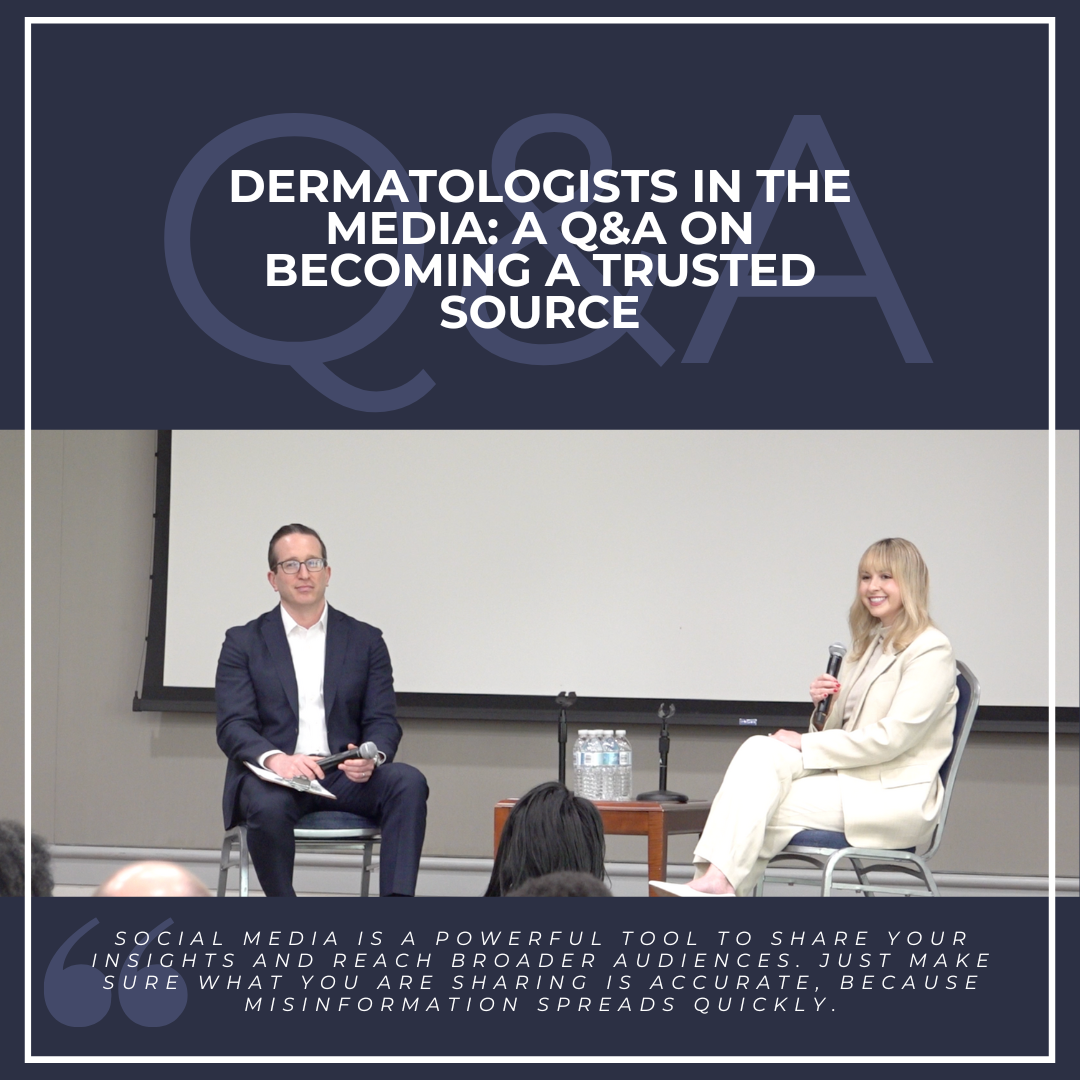In today’s digital media landscape, dermatologists are increasingly called upon to serve as trusted voices in the public conversation around skin health, beauty trends, and medical misinformation. For dermatology experts early in their career or seasoned dermatologists looking to enter the digital space, navigating the media can feel daunting. However, with the right approach, it becomes a valuable opportunity to educate the public.
This Q&A distills key takeaways from a recent conversation between Dr. Adam Friedman, MD, Professor and Chair of Dermatology at George Washington University School of Medicine, and Paige Stables, a beauty editor (formerly with Allure, Condé Nast) and creative consultant, at the first-of-its-kind Lab to Label Conference.  In this interview, Dr. Friedman asks relevant questions while Stables offers practical tips on building credibility, engaging with journalists, avoiding common pitfalls, and strategically using social media to share science-backed insights.
In this interview, Dr. Friedman asks relevant questions while Stables offers practical tips on building credibility, engaging with journalists, avoiding common pitfalls, and strategically using social media to share science-backed insights.
Q: What makes a dermatologist a credible and appealing source for journalists?
A: First and foremost: credibility. And board certification is non-negotiable. From there, journalists look for dermatologists who specialize in the topic at hand and stay up to date on current research and guidelines. Also, clear, concise, and honest communication is essential. It’s not just about knowing the science — it’s about being able to explain the topic like you would to a friend. Journalists value sources who can humanize their clinical expertise and offer balanced, educated perspectives.
Q: What are common mistakes dermatologists make when engaging with the media?
A: Speaking in too much medical jargon, over-promoting products they’re affiliated with, or juggling too many partnerships at once. Credibility can be compromised if your messaging appears biased. Another one is endorsing trends without scientific backing. Accuracy should always come before popularity — either support your claims with research or just clearly state that the data isn’t there yet to support a claim. Authenticity goes a long way.
Q: How do journalists decide what stories to run?
A: We always want to be part of the conversation—but journalists try to be the voice of reason. Editors may report on trends, but it’s typically done in an educational way. Sometimes stories are months in the making, while others come together in days, especially if tied to news or viral content. Journalists are more likely to include dermatologists as sources if they are responsive and timely — a quick turnaround can mean the difference between being quoted or not.
Q: Should dermatologists engage with social media? And if they do, how should they do it?
A: Yes, but thoughtfully. Dermatologists are experts on hair, skin, and nails and have a vital role to play in science-backed, accessible information. If you’re passionate about a topic, publishing research and speaking about it publicly can help establish your expertise. Social media is a powerful tool to share your insights and reach broader audiences. Just make sure what you are sharing is accurate, because misinformation spreads quickly.
Q: What’s the best way to start working with journalists or editors?
A: Establish relationships and reach out directly — beauty editors and health journalists are always looking to hear from new voices. Introduce yourself with a clear message about your specialty and why you would be a great resource. For example, reference a current research project and explain how your work connects to what the journalist is covering. You can also set Google Alerts for key topics to stay updated and identify journalists covering your areas of interest.
Q: Is it okay to say “I don’t know” when a journalist asks you a question?
A: Absolutely! Journalists appreciate honesty. If you’re not the best person to speak on a topic, refer them to someone who is. This builds long-term trust and positions you as a reliable connector in your field. It’s better to say, “That’s not my area, but I know someone who can help,” than to risk spreading misinformation or overreaching.
Q: How should dermatologists respond to media requests? Is an email or call better for an interview?
A: When possible, opt for a phone call over email interview— it’s more conversational and allows for richer dialogue. That said, it’s perfectly fine to ask for questions in advance to prepare. If answering by email, do your best to answer all the questions — keep in mind that each question was intentionally crafted. If you ever say something you wish you could rescind or feel misrepresented, you can reach out and request that it be kept off the record.
Q: How can new dermatologists or dermatology trainees break into media work?
A: You don’t need 20 years in practice to contribute. Share what you’re working on, what you’re seeing in clinic, or what you’re passionate about. Take initiative and be proactive in making connections. Participate in interviews, contribute to publications, and use platforms like LinkedIn to highlight your work. Comment on media posts, engage with articles, and make yourself visible. Organizations like the AAD Media Task Force are also excellent starting points for training and networking.
Conclusion
Engaging with the media allows dermatologists to shape the conversation about topics within their expertise with clarity, integrity, and evidence. By serving as a reliable source, being honest about the limits of your knowledge, and proactively sharing what you know, you can make a lasting impact far beyond the clinic. Whether through a well-timed interview about a hot topic, a thoughtful email to a journalist, or a credible voice on social platforms, every interaction is a chance to advocate for your patients, your peers, and your profession.
About the author
 Savanna Vidal is a medical student and pre-doctoral research fellow in the Department of Dermatology at the George Washington University School of Medicine and Health Sciences.
Savanna Vidal is a medical student and pre-doctoral research fellow in the Department of Dermatology at the George Washington University School of Medicine and Health Sciences.
Did you enjoy this article? You can find more on Navigating Your Career here.

